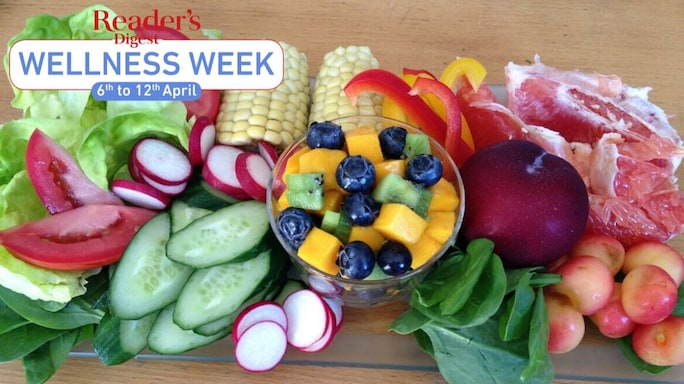- HOME
- /
- Better Living
- /
- Food
- /
The 5 Ps Of Eating Right
Nutritionist Ishi Khosla describes in detail the fundamentals of eating right to lead a healthy, disease-free life

The 1st P
Plan Your Day With Respect To Food As Food Situations May Not Always Be Predictable.
Engage and get involved in planning and making food decisions. You cannot be passive. It is as important as your business and professional plans.
Just the way you plan your day’s meetings, your clothes, plan your food. For example: if you are going to be on the move or if you have a working lunch or social obligation, so on and so forth. This will prevent surprises, situations like ‘oh I didn’t have a choice’. This will also prevent unwanted gaps, undesirable food intake and binge eating. If you are inclined towards cooking, innovate and explore new ways of cooking with new recipes and cuisines. Plan the ingredients in advance. Plan exercise and supplements.
Plan The Time When You Will Have Your Cereal/Grain.
Grains or cereals include rice, roti, bread etc. Cereals should not be confused with breakfast cereal. Every cuisine is represented by its staple grains like South Indian cuisine is known by rice, idli, dosa while North Indian cuisine is known by chapattis and parathas. Italian cuisine is almost synonymous with pasta. China has its noodles and rice. With the US it’s potatoes and breads that you think of first.
Grain or cereal should be eaten ideally before 7 p.m. and when you are hungriest. These can be paired with vegetables and proteins. Grains or cereals can be included once, twice or thrice a day or none at all, depending on individual requirements.
Plan Exercise
Eating before exercise is counter-productive specially if you are trying to lose weight. A high- carbohydrate snack like a fruit, lemon water with salt and coconut water are ideal. Post-exercise proteins combined with carbohydrates are best. A glass of vegetable juice will be great. Ideally, a gap of at least two hours between your meal and exercise is advisable. For high-intensity exercise, guidelines need to be modified.
Plan When You Will Have Your Supplements
Taking superfoods and supplements in the morning ensures better regularity. Keep your post dinner supplements on your bedside table. For travel or at work keep them in your bag/desk. Special pill boxes work well.
Plan Your Goal Posts
BMI, weight, waist size and other health goals.
Body mass index (BMI)
Measure of degree of obesity
BMI= Weight (kg)/ht (m2)
Ideal BMI < 23.0 kg /m2
Your ideal weight
- For men, 48 kg for the first 5 feet + 2.7 kg per inch
- For women, 45 kg for the first 5 feet + 2.5 kg per inch
Waist circumference (WC) (measured around abdomen)
- Women ≤ 80 cms (<31.5 inches)
- Men ≤ 90 cms (<35.5 inches)
 Image used for representative purposes only
Image used for representative purposes only
Calculate your caloric requirement.
- Weight in pounds x 15 for a normal lifestyle.
- Weight in pounds x 13 for a sedentary lifestyle.
Remember you first need to know what to eat and then use this as a guiding tool. Quality of calories is most important.
Practise The Principles Of Healthy Eating
Principles of healthy eating are common sense rules which allow you to practise healthy eating in a sustainable manner. Always keep these in mind when you plan: moderation, balance and variety.
Moderation
No food is good or bad; what matters is the amount you take. When you proclaim foods ‘off limits’, you are setting up a rule just waiting to be broken.
Balance
The principle of balance helps you undo the damage and lighten the next meal to compensate for the previous one. Balance may also be achieved by engaging in physical activity, by walking that extra mile. Balance can be anticipatory or retrospective. Anticipatory balance refers to the following—if you are likely to overeat later in the day, under-eat or lighten your meal before that. Retrospective balance implies damage control after eating more than you should have.
Balance can be adopted as a lifelong habit. Having alternate days of a detox diet with vegetables (soups/ salads/ steamed/ vegetables/ vegetable juices/ sprouts) along with some fruits is a great way to keep your diet excesses in check and from affecting you negatively. If not alternate days, then maybe at least the days after you’ve overeaten or eaten badly, a detox day will be helpful. This is also called alternate day fasting.
The popularity of the intermittent fasting diet is growing. This technique which limits the number of hours of eating has found its way into many people’s lives. For example, if you have eaten late at night the next day you will be better off either doing a detox diet or starting to eat later in the day, say, lunch time.
Variety
How many different foods do you eat every day: 10–15? Would it surprise you that one of Japan’s dietary guidelines suggested eating 30 different foods each day? Variety ensures that your body gets all the nutrients it needs. Make sure that you include foods from all the food groups, and maintain variety within food groups.
Eating a variety of foods prevents food sensitivities. For instance, within the ‘grains/cereal’ food group, eating a variety of grains is better than subsisting only on a single grain.
The 2nd P
Peak Hunger Time
Most of us have a specific time when we are hungriest. Understand your body clock and try to eat most of your food during those hours—at least your grain/ cereal. According to observational studies, the time between 5–7 coincides with maximum ordering in of snacks at work. It is prudent to plan your cereal intake at this time so that you avoid the temptation of eating unhealthy junk food (remember grains/ cereals are best eaten before 7 p.m.). If you are not hungry in the morning, lunch may be your first meal. If you like, you can maintain a food diary to know your peak hunger time. Resist eating late at night even if you are hungry.
 Be aware of the time when your hunger peaks (Illustration for representative purposes only. Source: Pixabay)
Be aware of the time when your hunger peaks (Illustration for representative purposes only. Source: Pixabay)
Data collected from about 10,000 clients at my centre suggests that peak hunger time is either around lunchtime or between 5 p.m. and 7 p.m. [...] It is advisable to eat a meal at this time and eat a lighter meal or healthy snack later. Aim to eat cereals/ grains, sandwiches, rotis, idlis etc. and then go home and have vegetables, soups, salad, fruits or some protein-rich food. You may also try and eat your last meal of the day by 8 p.m. If later than 8 p.m., then either skip the grain and have fruits, nuts, seeds, soup, or milk. Even then if you have eaten the grain, all is not lost. Go for a walk or balance the next day by eating more fruits, vegetables like a detox diet.
The 3rd P
Protein
Aim to include two protein rich meals in a day. These could be in the form of pulses, dals, nuts, dairy, eggs, lean meat, chicken and fish. Lentil pancakes (chillas) should also be counted as proteins. Eating a couple of servings of dals and pulses a day is adequate as excess could lead to gastric distress and bloating. There is a tendency towards too much protein among the youth. Taking protein supplements has become the norm for those going to gyms. This is not warranted unless you are engaged in high levels of sporting activity. If you engage in intensive physical exercise like endurance exercise or heavyweight training, protein intake would need to increase. In most individuals doing moderate exercise, dietary protein should be enough to meet requirements. Excess animal protein should also be avoided.
The 4th P
Pair The Protein With Vegetables
Proteins are acidic in nature and are best taken with an alkaline food like vegetables or fruits. Ensuring that you combine protein with salads, vegetable juices, cooked vegetables or fruits makes them easier to digest and also provides more fibre to aid digestion.
Protein Ideas
- Plant protein: Lentil pancakes (chilla), moong idli, moong dal, laddu, sprouts, chana chaat, matra, chana tikki, dhokla, khandvi, falafel, sundal, vegetable pakora, vada, dal dosa, sautéed peas and mushrooms.
- Animal protein: Eggs, chicken kebabs, chicken grilled, chicken stir-fry, fish steamed, fish grilled, fish cutlets, fish fried, lamb kebabs, lamb stew.
The 5th P
Protective Foods
Vegetables and Fruits: Not only do vegetables and fruits fortify our health, they also lay the foundation of good eating. Loaded with antioxidants, phytochemicals, vitamins, minerals and fibre, this low-calorie, high-nutrient group is one of the most valuable elements in our current lifestyles. This group has been called protective foods simply because they have phytonutrients (plant nutrients) which help fight diseases. Those which have exceptionally high levels of phytonutrients are also popularly called superfoods.
Vegetables and fruits are central to good health and make sure you include fruits and also a good mix of both raw and cooked vegetables to make the most of their benefits.
However, while fruits are loaded with antioxidants and micronutrients, they are also a source of sugar (fructose), so a modest intake of fruit (1-3 servings) is adequate. Avoid fruit juices as they are concentrated sources of sugar and spike our blood sugar leading to imbalance of insulin levels resulting in sugar cravings, low blood sugars, belly fat, fatty liver and high uric acid.
Superfoods: Food has been recognized as a medicine for thousands of years. Good food is medicine and can help delay, prevent, and, at times, treat diseases. Wrong food can make us unwell and sick. Several dietary constituents and nutrients are comprehensively documented with their protective roles in health and diseases. The kitchen is indeed the best pharmacy. One needs to be knowledgeable about these foods and their benefits. Include aloe vera, amla, turmeric, ginger, basil, spirulina, curry leaves, moringa, seaweeds, berries, spice waters, dry fruits, nuts and seeds in your diet.
 It's necessary to include superfoods in your diet.
It's necessary to include superfoods in your diet.
How Much To Eat
Grains/Cereals: On an average, a moderately active person may consume 5–8 servings of grain/cereal in a day. But those trying to lose weight should reduce the portion.
Proteins (Legumes and Dairy, Eggs, Meat, Fish): Include at least 2–3 servings of pulses/legumes/lentils, beans, if you are a vegetarian. However, if you consume animal protein as dairy, eggs, meat, fish, these may be only 0–2 servings each day depending on your consumption of these. Try and include a serving of sprouts on most days as they are little nutrient factories which also contain beneficial enzymes.
Vegetables: Vegetable servings can be at least 4–6 servings a day. 50% of these should be eaten raw. One serving is about half cup of most vegetables and one cup of green leafy vegetables.
Fruits: Try and include at-least 1–2 seasonal fruits a day.
Nuts and Seeds: A fistful or 30–50 gms a day is a reasonably healthy portion.
 Book cover courtesy Simon & Schuster India
Book cover courtesy Simon & Schuster India






